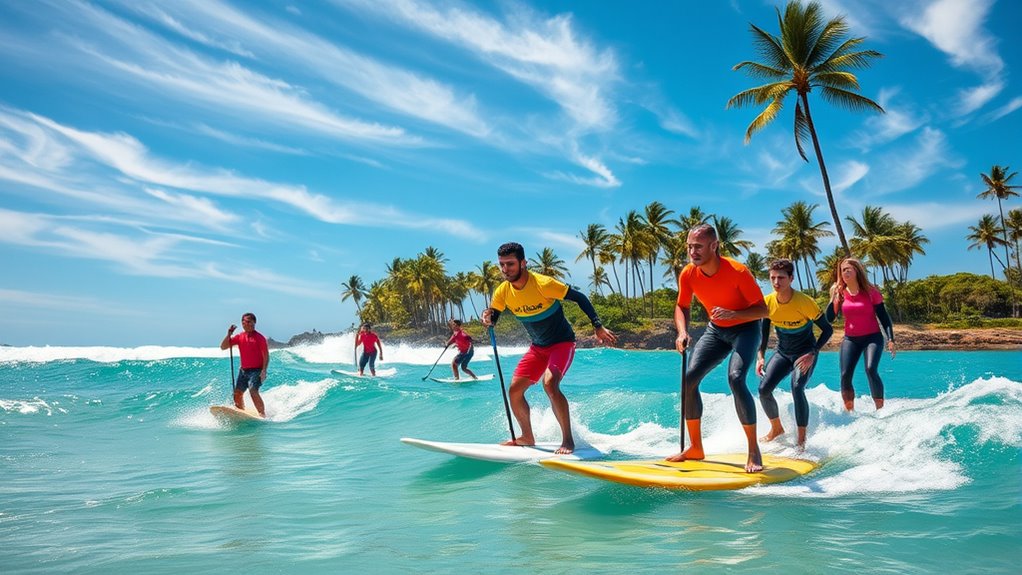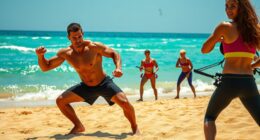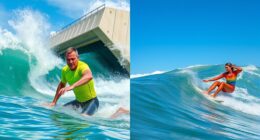To improve your surfing, focus on strengthening your core with planks and leg raises, boosting balance with single-leg stands and BOSU ball exercises, and building paddling power through push-ups and resistance pulls. Incorporate plyometric drills like jump squats for explosive moves, and don’t forget flexibility routines such as yoga stretches to enhance mobility. Maintaining endurance with cardio and paddling can keep you energized. Keep going, and you’ll discover even more ways to elevate your skills and ride those waves with confidence.
Key Takeaways
- Strengthen your core with exercises like planks and Russian twists to improve stability and control on the surfboard.
- Practice balance drills such as single-leg stands and BOSU ball exercises to enhance responsiveness on uneven surfaces.
- Increase paddling power through resistance training, push-ups, and paddle-specific drills to catch waves efficiently.
- Incorporate plyometric exercises like jump squats and box jumps to develop explosive strength for quick maneuvers.
- Improve flexibility and endurance with stretching, yoga, and cardio routines to enhance mobility and overall stamina.
Core Strengthening Movements
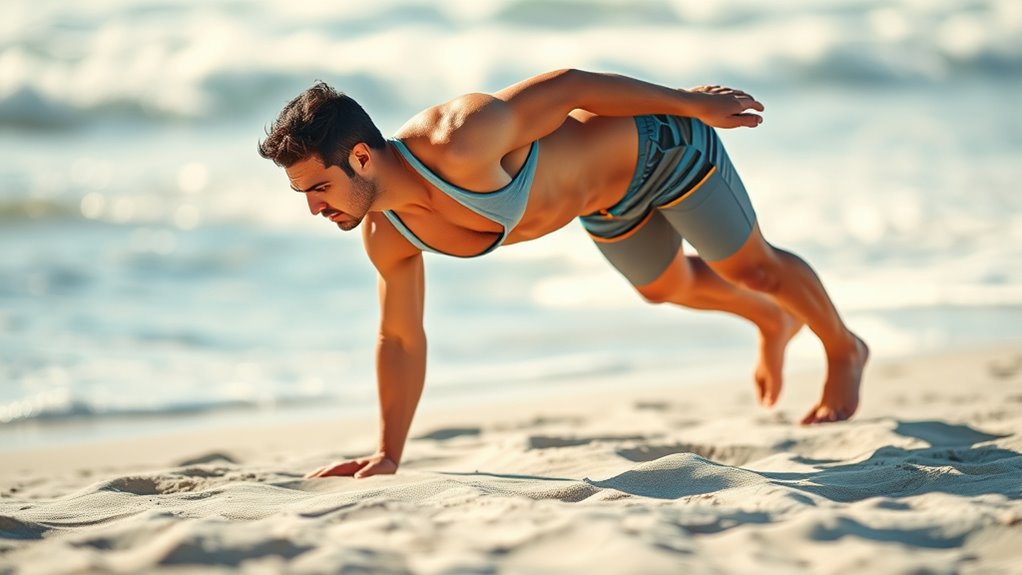
Building a strong core is essential for improving your surfing performance, as it provides stability and control on the board. When it comes to surfboard selection, a solid core helps you maneuver better and adapt quickly to changing wave conditions, especially with wave prediction. Core exercises like planks, Russian twists, and leg raises strengthen the muscles that keep you balanced on the board. A stable core allows you to stay centered during rapid turns and sudden shifts in wave motion. Additionally, incorporating advanced training techniques can further enhance your core strength and overall performance. Developing a comprehensive risk assessment for your training routine ensures you avoid potential injuries while enhancing your core stability. By consistently integrating core movements into your training, you’ll enhance your ability to read waves accurately and respond swiftly. Proper training methods can optimize your workout effectiveness and help prevent overtraining or injuries. This foundation improves overall surfing skills, making your rides smoother and more controlled, regardless of surf conditions or surfboard type.
Balance and Stability Drills
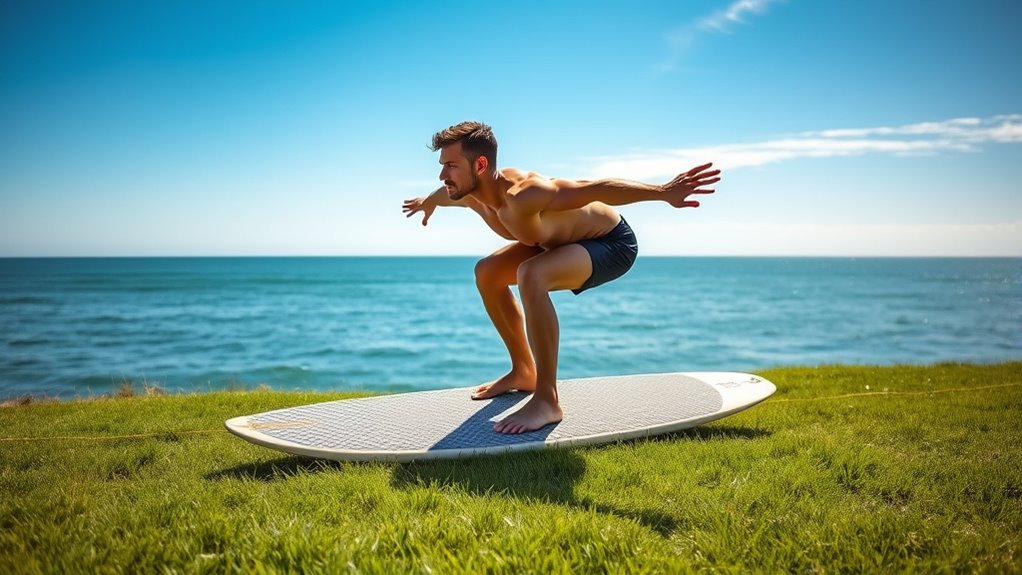
To improve your surfing performance, incorporating balance and stability drills into your training is essential. These exercises help you stay steady on the board, especially when wave reading and tide timing are unpredictable. Focus on these key drills:
Enhance your surfing by practicing balance and stability drills for better control and wave response.
- Single-leg stands: Improve ankle stability, vital for adjusting to changing wave conditions.
- BOSU ball exercises: Simulate surfboard balance, enhancing your ability to stay centered on uneven surfaces.
- Board balancing: Use a paddleboard or balance pad to practice maintaining stability, sharpening your response to wave shifts and tide changes.
- Regular practice of these drills assists in building resilience against AI vulnerabilities that could impact your training consistency and safety.
Paddling Power Exercises
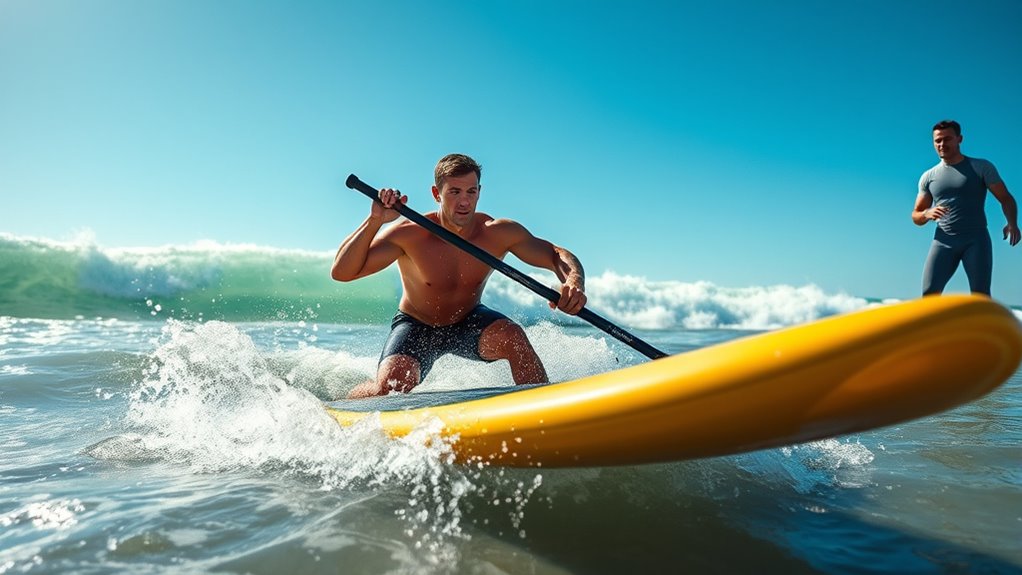
Enhancing your paddling power directly boosts your ability to catch waves early and maintain control throughout your ride. Strong paddling helps you improve wave timing, so you’re in position sooner and can seize the best waves. Focus on exercises that target your back, shoulders, and core, such as push-ups, resistance band pulls, and paddle-specific drills. These build endurance and strength, making paddling more efficient. When choosing a surfboard, opt for a shape that suits your paddling strength and skill level; a slightly larger or thicker board can make paddling easier as you develop power. Consistent practice with paddling drills enhances your efficiency, allowing you to conserve energy and maximize your wave-catching opportunities. Incorporating caffeine content in espresso into your pre-surf routine can provide a temporary boost in alertness and endurance, helping you paddle harder. Understanding city dynamics is crucial for adapting to new environments and optimizing your surfing sessions in different locations. Staying informed about local surf conditions and environmental factors can significantly improve your overall experience. Additionally, being familiar with headphone types and connectivity can help you listen to weather updates or training audio during indoor practice sessions. Better paddling translates directly into more successful sessions in the water, especially when considering projector specifications that can simulate different lighting conditions for training indoors.
Plyometric Training for Explosiveness
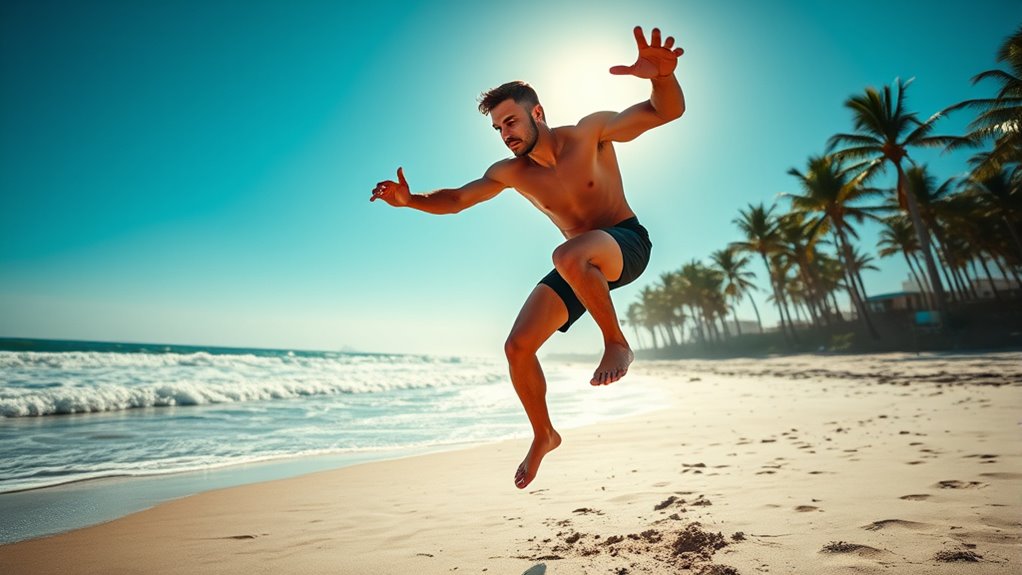
Plyometric training is crucial for developing explosive power, which is essential for quick, powerful takeoffs and sharp maneuvers on your surfboard. This training enhances your ability to synchronize with wave timing and maintain better surfboard control. To maximize results, focus on:
Boost your surf skills with plyometric training for explosive power and quick maneuvers.
- Jump squats to boost leg power and improve explosive push-offs.
- Box jumps to develop rapid, controlled movements necessary for quick wave responses.
- Clap push-ups to increase upper body explosiveness, aiding in paddle strength and wave catching.
Flexibility and Mobility Routines
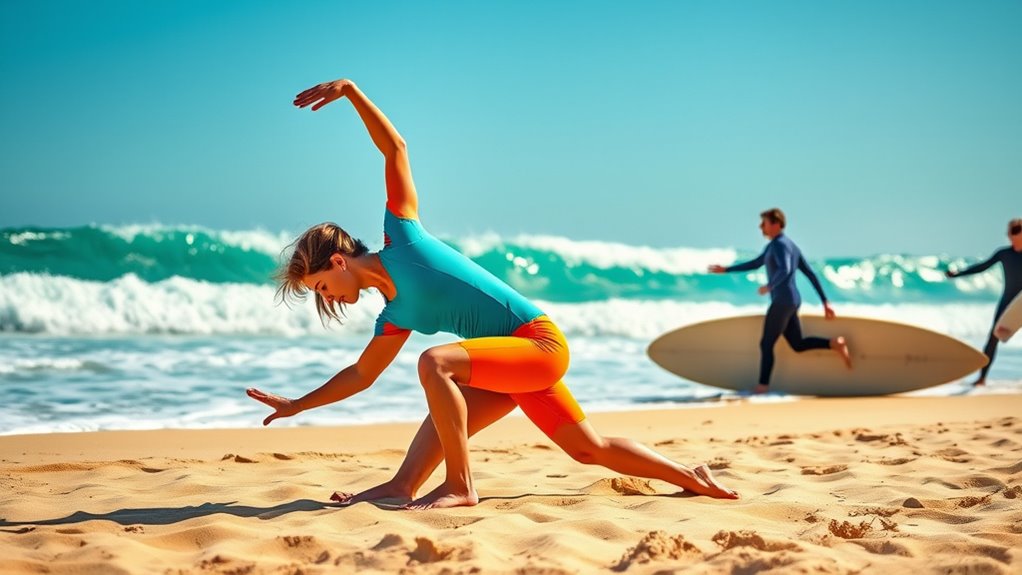
Incorporating regular flexibility and mobility routines is essential for improving your surfing performance and preventing injuries. Start with targeted stretching routines to enhance your range of motion and prepare your muscles for dynamic movements. Focus on hamstring, hip, and shoulder stretches to increase flexibility in key surfing muscles. Incorporate yoga poses like downward dog, pigeon pose, and cobra to boost mobility and strengthen stabilizing muscles. These exercises help you maintain better balance on the board and execute sharper turns. Consistent practice of stretching routines and yoga poses also reduces muscle tightness and improves overall body awareness. Keep your routines simple, perform them daily, and listen to your body to maximize the benefits for your surfing skills and injury prevention.
Endurance Building Practices
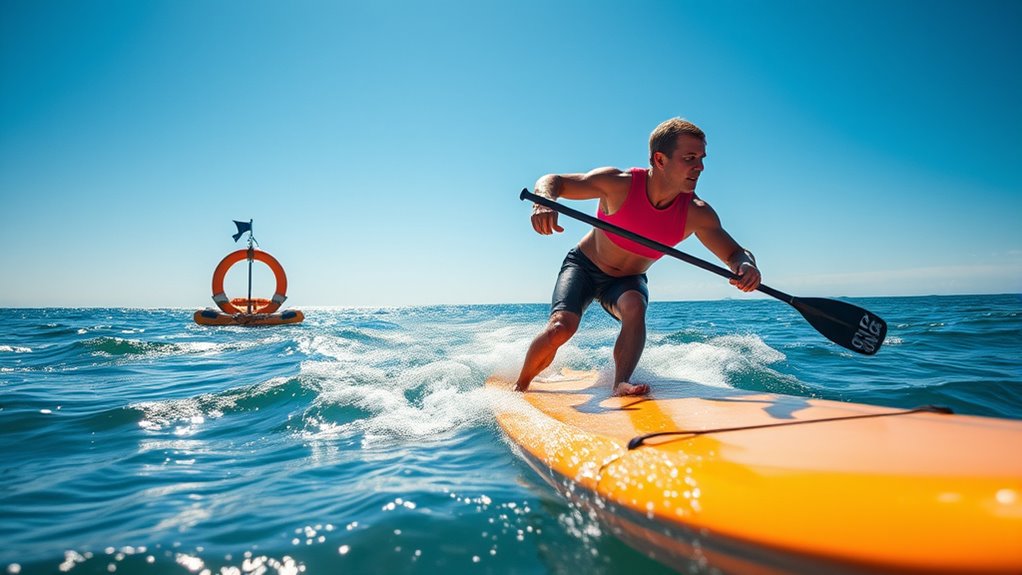
How can you guarantee you have the stamina to stay focused and perform your best during extended surf sessions? Building endurance is key. First, incorporate cardiovascular exercises like running or cycling to improve overall stamina. Second, practice paddling consistently to simulate surf conditions, paying attention to wave timing and conserving energy. Third, include interval training to boost your ability to catch waves and maintain effort during long sessions. Fourth, understanding restaurant hours today list techniques can help you optimize your physical preparedness and recovery. Maintaining good surf etiquette, such as respecting others’ space and wave priority, helps prevent unnecessary fatigue from conflicts and distractions. Additionally, integrating lifestyle for longevity practices like stress management and adequate sleep can further support your stamina and overall health. These practices ensure you’re physically prepared, stay alert, and can handle the physical demands of prolonged surf sessions, making every wave count and keeping your energy high from start to finish.
Frequently Asked Questions
How Often Should I Incorporate These Exercises Into My Surfing Routine?
You should aim for consistent exercise frequency to improve your surfing skills. Incorporate these exercises into your routine at least 3-4 times a week to build strength and endurance. Training consistency is key, so make it a regular part of your schedule. Adjust the frequency based on your progress and how your body feels, but staying committed will help you see steady improvements in your surfing performance.
Are There Specific Exercises for Different Skill Levels or Ages?
Like a tailor crafting a suit, you can customize exercises to fit your age and skill level. Age-specific drills focus on safety and mobility, while skill level adjustments challenge or ease your progress. Whether you’re a beginner or advanced, these tailored moves help you grow stronger and more confident. Adapting exercises guarantees you stay motivated and avoid injury, turning every session into a step closer to mastering the waves.
How Can I Prevent Injuries While Performing These Training Exercises?
To prevent injuries during training exercises, you should always start with a proper warm-up to prepare your muscles and reduce strain. Focus on maintaining correct technique throughout each exercise, as improper form increases the risk of injury. Listen to your body, don’t push through pain, and gradually increase intensity. Staying mindful of these practices helps keep you safe while improving your surfing skills.
What Equipment Is Necessary for Effective Training at Home or the Gym?
Think of your equipment as the key to unlocking your full surfing potential. You’ll need a yoga mat for balance drills and core stability exercises, resistance bands to build strength, and a stability ball for engaging your core. Dumbbells or kettlebells can add resistance. A foam roller helps with recovery. With these essentials, you can create a solid foundation at home or in the gym, fueling your progress on the waves.
Can These Exercises Help Improve Surfing in Big Wave Conditions?
These exercises can definitely help improve your surfing in big wave conditions. By focusing on building wave endurance, you’ll last longer in powerful surf, and enhancing your core stability will give you better control and balance. Consistently training these areas prepares you physically for the demands of big waves, helping you stay safe and perform better. So, yes, targeted exercises can make a significant difference when tackling challenging, large surf.
Conclusion
By incorporating these training exercises into your routine, you’ll find yourself catching waves more effortlessly. Imagine standing on your board as the sunrise reflects off the water, your core strong and your balance steady. As you paddle out with renewed power and agility, each movement becomes smoother, like the ocean’s gentle swell guiding you. With consistent effort, you’ll soon notice that surfing feels more natural—almost like the waves are moving to your rhythm.

